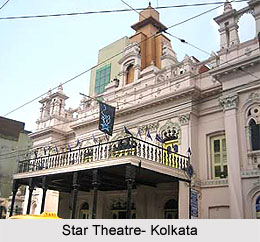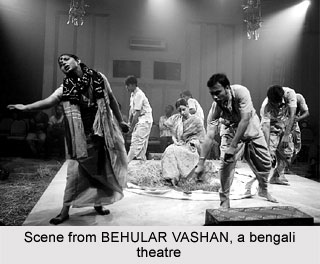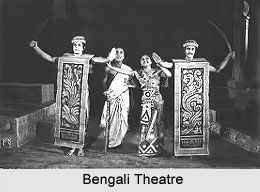 Development of Bengali theatre and its consolidated rise can be attributed to the two major players during that era- the Star and the Minerva. The Star Theatre was set up in 1883, by a group of actors led by Girish Ghosh. The money for building the playhouse was advanced by another Rajasthani businessman, mainly at the instance of Binodini Dasi. The new playhouse opened in July, 1883 with a mythological play by Girish Ghosh. It soon led the other playhouses in fame and popularity. However, the band of actors and actresses who had made Star the leading theatre left when, four years later, it was purchased by a wealthy landowner. They raised money and built a new playhouse at the site where Star Theatre now stands.
Development of Bengali theatre and its consolidated rise can be attributed to the two major players during that era- the Star and the Minerva. The Star Theatre was set up in 1883, by a group of actors led by Girish Ghosh. The money for building the playhouse was advanced by another Rajasthani businessman, mainly at the instance of Binodini Dasi. The new playhouse opened in July, 1883 with a mythological play by Girish Ghosh. It soon led the other playhouses in fame and popularity. However, the band of actors and actresses who had made Star the leading theatre left when, four years later, it was purchased by a wealthy landowner. They raised money and built a new playhouse at the site where Star Theatre now stands.
The other playhouse which contributed to the consolidation of Bengali theatre and is still there was Minerva. Minerva Theatre was built with money provided by a grandson of Prasanna Kumar Tagore, founding fellow of University of Calcutta. Once again Girish Ghosh was approached and, he agreed to lend his services. The new theatre opened on 28th January, 1893 with Macbeth, translated by Girish Ghosh himself. The choice of the play, the praise showered on the production and the lack of popular support throw some light on the problems the pioneers of commercial theatre faced. Girish Ghosh regarded Shakespeare with adoration. In this he conformed to the general attitude of the educated Bengali of his times. A well-known Bengali poet of the nineteenth century went so far as to say in one of his poems that Kalidasa belonged to India but Shakespeare to the world.
Girish Ghosh had wanted the average theatregoer to be acquainted with the Bard`s plays and nursed the hope of producing a number of his tragedies. But after the decisive rejection of Macbeth, by the public, he had to drop his plans for producing Hamlet, Othello and King Lear. He was sorely disappointed. The educated elite of the city who knew their Shakespeare were extravagant in their praise. So were the newspapers. Even the Englishman congratulated the group.
 As with other playhouses, there were changes of ownership and management in Minerva, actors left and came back; there were intrigues, rivalries and quarrels. But in spite of all this Minerva succeeded in building up a tradition of its own. In common with others, it was basically built around personalities. A number of remarkable actors, actresses, playwrights and promoters served the cause of theatre with rare zeal and devotion. Girish Ghosh stands out but others like Ardhendu Mustafi, Amarendra Dutta, Amritalal Mitra, and Binodini Dasi-to mention only a few-contributed greatly to the development of Bengali theatre.
As with other playhouses, there were changes of ownership and management in Minerva, actors left and came back; there were intrigues, rivalries and quarrels. But in spite of all this Minerva succeeded in building up a tradition of its own. In common with others, it was basically built around personalities. A number of remarkable actors, actresses, playwrights and promoters served the cause of theatre with rare zeal and devotion. Girish Ghosh stands out but others like Ardhendu Mustafi, Amarendra Dutta, Amritalal Mitra, and Binodini Dasi-to mention only a few-contributed greatly to the development of Bengali theatre.
As mentioned earlier, Star was ousted from the playhouse at Beadon Street where it was first started in 1883. The wealthy Gopal Seal who purchased the playhouse and threw Star out in 1887 was, however, denied the right to use the prestigious name. He gathered most of the actors of the old National and opened The Emerald in October, 1887 with a play on the exile of the Pandavas. He was able to secure the services of Ardhendu Mustafi among others and sank a lot of money in doing up the playhouse. There was no electricity for domestic consumption then and plays were acted in gaslight. Gopal Seal installed a dynamo generator and the spectators were thrilled, particularly by the costumes shining in the electric light. He managed, by a mixture of threat and blackmail, to get the services of Girish Ghosh but lost at the same time those of Ardhendu Mustafi. The Emerald prospered for some time. But after a while and several shuffles of the pack Gopal Seal leased out the playhouse to others; whereupon Girish Ghosh promptly left to rejoin the Star. After several vicissitudes of fortune Emerald was wound up in April, 1897.
 The new group which now got hold of the playhouse was in some ways a truly `new` one. It was the creation of Amarendra Dutta whose aristocratic and scholastic family background could not curb his enthusiasm for the theatre and his resolve to beat a rival theatre in drawing crowds whatever the means. His Classic Theatre started with a play by Girish Ghosh in April, 1897 followed in June, by Hariraj, a Bengali adaptation of Hamlet, which the public liked, soon after Amarendra Dutta produced Tagore`s Raja O Rani. From which it is not to be inferred that he was motivated by any mission of improving the taste of the average member of the audience. He had a magnificent stage presence, a resonant voice, natural acting ability and an intuitive rapport with the spectators. All of which he employed with panache to dress up a play in a manner they found attractive. He had, however, no head for business and even though Classic was where the people went, Amadendra Dutta`s extravagance and mismanagement brought the theatre to an untimely end in 1906. A wealthy zamindar, Sarat Kumar Ray, purchased the playhouse, engaged managers, actors, musicians and stage hands, arranged with playwrights, renovated the building and called the theatre Kohinoor. It opened with Kshirode Prasad Vidyabinode`s Chand Bibi in August, 1907. Getting this outstanding playwright into a contractual obligation was Kohinoor`s biggest gain. In course of time some of the leading and, by now slightly the worse for wear actors and actresses like Girish Ghosh, Ardhendu Mustafi, Chunilal Deb, Tincowri Dasi and Tara Sundari joined, then left, then joined again. Predictably there was litigation and Kohinoor was sold to Manmohan Pande, a wealthy contractor, in 1912.
The new group which now got hold of the playhouse was in some ways a truly `new` one. It was the creation of Amarendra Dutta whose aristocratic and scholastic family background could not curb his enthusiasm for the theatre and his resolve to beat a rival theatre in drawing crowds whatever the means. His Classic Theatre started with a play by Girish Ghosh in April, 1897 followed in June, by Hariraj, a Bengali adaptation of Hamlet, which the public liked, soon after Amarendra Dutta produced Tagore`s Raja O Rani. From which it is not to be inferred that he was motivated by any mission of improving the taste of the average member of the audience. He had a magnificent stage presence, a resonant voice, natural acting ability and an intuitive rapport with the spectators. All of which he employed with panache to dress up a play in a manner they found attractive. He had, however, no head for business and even though Classic was where the people went, Amadendra Dutta`s extravagance and mismanagement brought the theatre to an untimely end in 1906. A wealthy zamindar, Sarat Kumar Ray, purchased the playhouse, engaged managers, actors, musicians and stage hands, arranged with playwrights, renovated the building and called the theatre Kohinoor. It opened with Kshirode Prasad Vidyabinode`s Chand Bibi in August, 1907. Getting this outstanding playwright into a contractual obligation was Kohinoor`s biggest gain. In course of time some of the leading and, by now slightly the worse for wear actors and actresses like Girish Ghosh, Ardhendu Mustafi, Chunilal Deb, Tincowri Dasi and Tara Sundari joined, then left, then joined again. Predictably there was litigation and Kohinoor was sold to Manmohan Pande, a wealthy contractor, in 1912.
Of the other playhouses Bengal Theatre or Royal Bengal Theatre as it called itself later, had a comparatively long lease of life and carried on till 1901. Its dubious distinction was that it refused to change with the times. The refusal however was not altogether without merit. It earned the owners a reputation for certain principles of conduct. They avoided the unseemly squabbles, intrigues, instigated break-ups and actor-snatching that had become endemic. Except for brief periods it could boast of no leading actor on its pay-roll but managed to retain the loyalty of sections of the public. But it could not possibly continue to serve stale fare and yet survive. After its closure in 1901, the playhouse was taken on lease by one Guruprasad Maitra. His Aurora Theatre lasted for a year and a half and was succeeded by Unique Theatre which lasted even less. The next lessee could not even think of a new name and called it National Theatre. It was unable to compete with the popularity of Kohinoor and Minerva and tried at first to lure customers by offering free gifts and then reduced the prices. Neither helped! It lingered on for six years and closed down in January, 1911. To bring the story of this particular playhouse to a close, Amarendra Dutta took it on lease, persuaded the proprietor Anath Deb to spend a lot of money in renovating the building, formed a new group, called it "The Great National" and appointed himself the manager. He was doing rather well when, in less than six months` time, he broke up the group and rejoined Star on being offered part proprietary rights.
 To return to Star, Girish Ghosh was unable to join it formally when it began functioning again in May 1888 in the new playhouse built at its present site in Cornwallis Street. But it was his inspiration and help in ideas, money and labour that made the new theatre possible. His heart was with the Star and he joined it as manager as soon as he had an opportunity of getting out of his contractual obligation with Emerald. His renewed association with Star lasted for about ten years and was extraordinarily fruitful. He wrote some of his best plays during this period. Such was the foundation that he laid for the theatre that even after he left it in 1898, Star never looked back.
To return to Star, Girish Ghosh was unable to join it formally when it began functioning again in May 1888 in the new playhouse built at its present site in Cornwallis Street. But it was his inspiration and help in ideas, money and labour that made the new theatre possible. His heart was with the Star and he joined it as manager as soon as he had an opportunity of getting out of his contractual obligation with Emerald. His renewed association with Star lasted for about ten years and was extraordinarily fruitful. He wrote some of his best plays during this period. Such was the foundation that he laid for the theatre that even after he left it in 1898, Star never looked back.
One other playhouse may be briefly mentioned. This was built away from the Beadon Street locality by Rajkrishna Ray-the only instance of an actor-playwright building a playhouse on his own. At considerable personal sacrifice he started his Bina Ranga-bhumi at 38, Mechuabazar Street in 1887. By then, the practice of engaging women to play female roles had become general. Rajkrishna Ray, who was something of a puritan, made male actors to render female parts. People praised his principles and his plays but few went to see them. He was financially ruined and gave up within a few months. He came back later, a sadder and wiser man, to take charge of the theatre he had built. He employed women actresses this time and made the rates of admission ridiculously and disastrously low. Eventually this simple and good man, who loved drama and theatre deeply, had to give up ownership of Bina in 1891. Thereafter in the course of several changes in ownership- the playhouse had a string of new names, The Indian, The Gaiety, The Victoria Opera, etc -it was later taken over to show "moving pictures", the new medium that made its tentative appearance in Kolkata at about that time




















